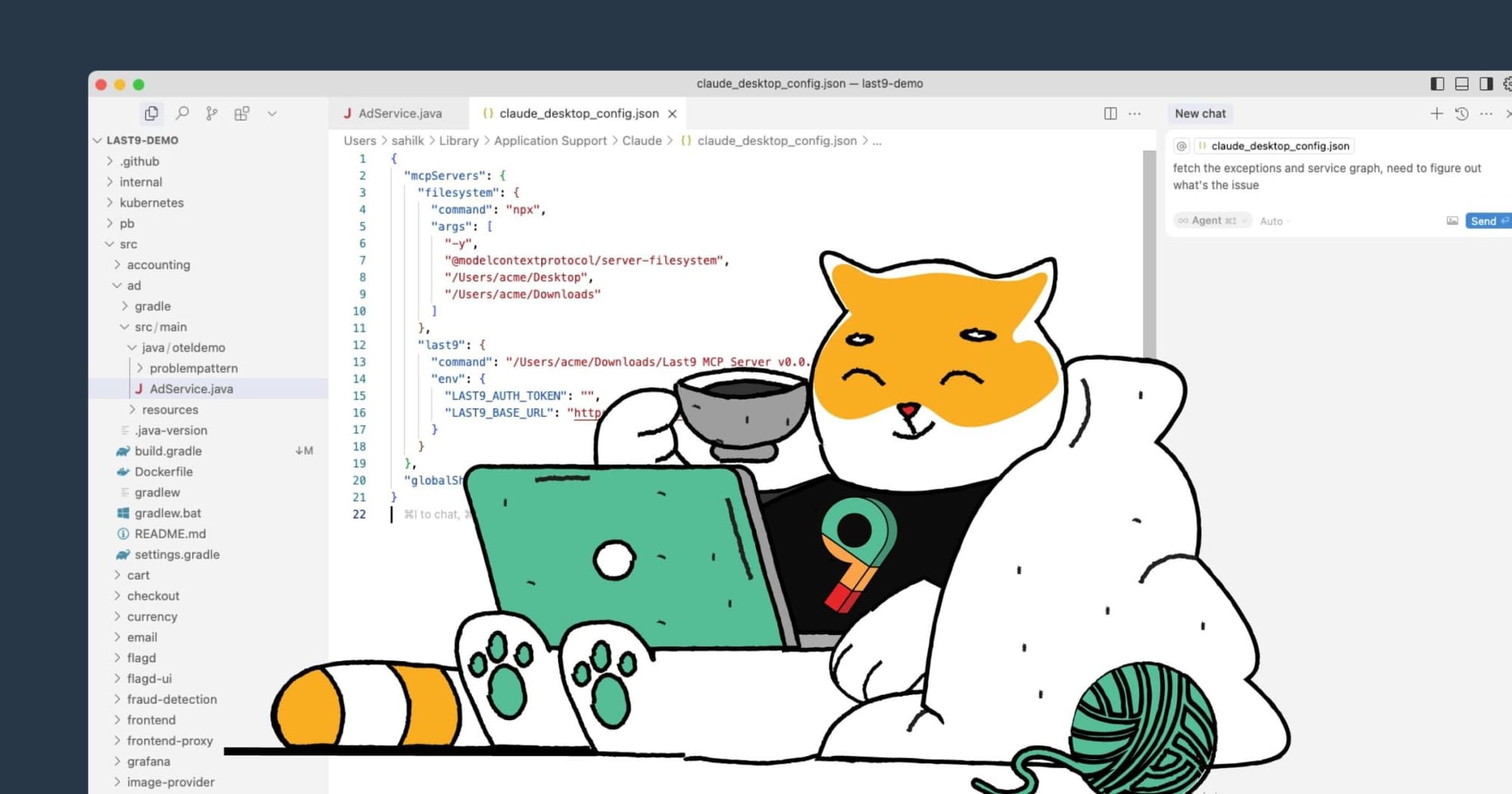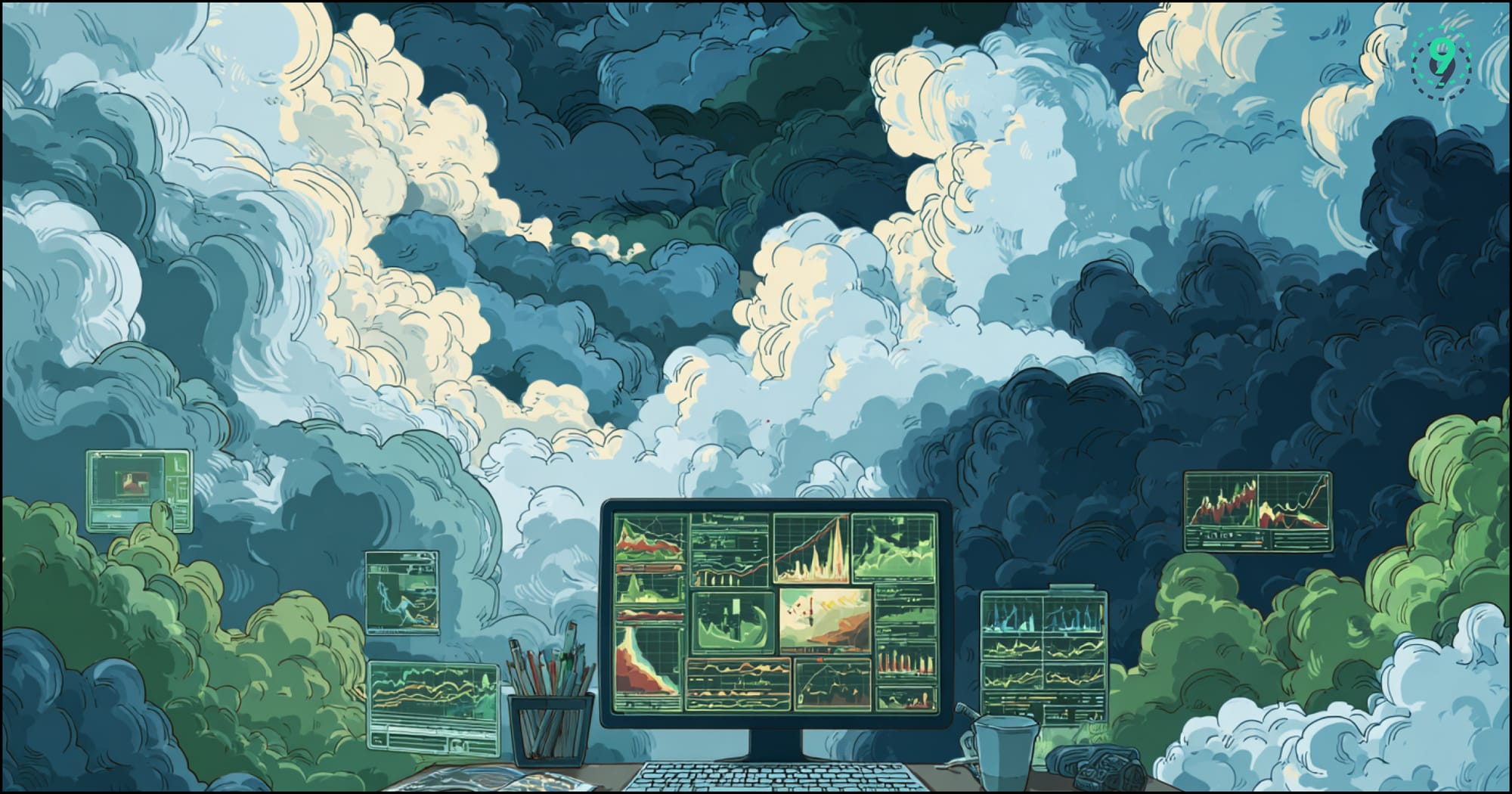In modern microservices architectures, container observability is crucial for maintaining reliability and performance. It helps teams detect issues early and optimize distributed systems.
This guide will walk you through the essentials of container observability, including advanced techniques and troubleshooting strategies to ensure your containerized applications run smoothly.
What is Container Observability?
Container observability refers to your ability to understand what's happening inside your containerized applications and infrastructure. Unlike traditional monitoring, which tells you if something is wrong, observability helps you understand why it's wrong.
Container observability focuses on three primary data types:
- Metrics: Numerical measurements collected at regular intervals (CPU, memory usage, request counts)
- Logs: Text records of events that occurred within your containers
- Traces: Records of requests as they flow through distributed services
When these three elements come together, you get a complete picture of your containerized environment's health and performance.
The Critical Need for Visibility in Dynamic Environments
For containerized applications, traditional monitoring approaches fall short. Here's why:
- Ephemeral nature: Containers come and go, making it hard to track issues
- Dynamic scaling: Container counts change constantly based on load
- Microservices complexity: Request paths span multiple services
- High cardinality data: The sheer volume of metrics can be overwhelming
With proper container observability, you can:
- Find and fix problems faster
- Reduce mean time to resolution (MTTR)
- Optimize resource usage and costs
- Improve application performance
- Make data-driven scaling decisions
The Three Pillars of Container Observability
Essential Data Points for Health Monitoring
Metrics are the foundation of container observability. They provide numerical data about your system's performance over time.
Key container metrics to track:
| Metric Type | Examples | Why It Matters |
|---|---|---|
| Resource Usage | CPU, memory, disk I/O | Helps identify resource bottlenecks |
| Application Performance | Request rates, error rates, latency | Shows user experience quality |
| Network | Bytes in/out, connection counts | Identifies network-related issues |
| Container Lifecycle | Start/stop times, restart counts | Reveals stability problems |
Popular tools for collecting container metrics include:
- Last9: A unified telemetry data platform that handles high-cardinality observability at scale, perfect for containerized environments
- Prometheus: An open-source metrics collection system with a powerful query language
- OpenTelemetry: A vendor-neutral framework for collecting metrics, logs, and traces
Key Strategies for Ephemeral Environments
While metrics tell you something's wrong, logs help you understand why. Container logging comes with unique challenges:
- Containers are ephemeral—when they die, their logs disappear
- Log volume scales with container count
- Standard output and standard error are your main log sources
Best practices for container logging:
- Centralize logs: Send all container logs to a central location
- Use structured logging: JSON or similar formats make logs easier to parse
- Add context: Include request IDs, container IDs, and service names
- Set appropriate log levels: Too much logging creates noise
Popular container logging solutions:
- Last9: Unifies logs with metrics and traces for correlated analysis
- Fluentd/Fluent Bit: Lightweight log collectors designed for containers
- Loki: Horizontally scalable log aggregation system

Implementing Distributed Tracing
In a microservices architecture, a single user request might touch dozens of services. Distributed tracing helps you follow these requests across your entire system.
Key components of distributed tracing:
- Trace ID: A unique identifier for each request
- Spans: Individual operations within a trace
- Context propagation: Passing trace information between services
Leading distributed tracing tools:
- Last9: Provides correlated tracing integrated with metrics and logs
- Jaeger: Open-source, end-to-end distributed tracing
- OpenTelemetry: A Standardized way to instrument applications for traces
Implementing Container Observability in Kubernetes: A Step-by-Step Guide
Kubernetes is the most popular container orchestration platform. Here's how to implement observability in a Kubernetes environment:
Setting Up Kubernetes Metrics Collection: Tools and Configurations
- Deploy a metrics collector: Install Prometheus or OpenTelemetry collectors
- Set up exporters: Use node-exporter for host metrics and kube-state-metrics for Kubernetes-specific metrics
- Configure scraping: Set up Prometheus to scrape your metrics endpoints
- Create dashboards: Visualize your metrics using Grafana or other visualization tools
Example Prometheus configuration for scraping container metrics:
scrape_configs:
- job_name: 'kubernetes-pods'
kubernetes_sd_configs:
- role: pod
relabel_configs:
- source_labels: [__meta_kubernetes_pod_annotation_prometheus_io_scrape]
action: keep
regex: trueBuilding a Robust Container Logging Infrastructure: Best Practices
- Choose a log collector: Deploy Fluentd or Fluent Bit as a DaemonSet
- Configure log forwarding: Send logs to your centralized logging system
- Set up log parsing: Extract structured data from your logs
- Create log dashboards and alerts: Visualize and monitor your logs
Example Fluent Bit configuration:
[INPUT]
Name tail
Path /var/log/containers/*.log
Parser docker
Tag kube.*
Refresh_Interval 5
Mem_Buf_Limit 5MB
Skip_Long_Lines On
[OUTPUT]
Name http
Match kube.*
Host logging-service
Port 8888
Format jsonDeploying Distributed Tracing in Kubernetes: Implementation Guide
- Instrument your applications: Add OpenTelemetry instrumentation to your code
- Deploy a tracing backend: Set up Jaeger or another tracing system
- Configure sampling: Decide how many traces to collect
- Visualize traces: Use the tracing system's UI to analyze request flows
Container Observability Beyond Kubernetes: Other Orchestration Platforms
While Kubernetes dominates the container orchestration space, it's not the only option. Here's how to approach observability in other environments:
Docker Swarm Observability: Monitoring Made Simple
Docker Swarm offers a simpler orchestration alternative that still needs robust observability:
- Metrics with cAdvisor: Docker's built-in container advisor provides basic metrics
- Log collection: Configure the Docker logging driver to forward logs
- Distributed tracing: Use the same application instrumentation approach as with Kubernetes
Observability for Cloud-Native Container Services: ECS, AKS, and GKE
Cloud providers offer managed container services with their observability considerations:
- AWS ECS/Fargate: Integrate with CloudWatch for metrics and logs
- Azure AKS: Leverage Azure Monitor for container insights
- Google GKE: Use Cloud Monitoring and Cloud Logging
The challenge lies in maintaining consistent observability across these different platforms—this is where vendor-neutral solutions like OpenTelemetry and Last9 shine.
Serverless Container Observability: Monitoring Functions-as-a-Service
Serverless containers (like AWS Fargate and Google Cloud Run) present unique observability challenges:
- You have less access to the underlying infrastructure
- Cold starts create performance variability
- Resource allocation happens automatically
Key strategies for serverless container observability:
- Focus on application-level instrumentation: You can't access the host, so instrument your code
- Track cold starts: Monitor and optimize initialization times
- Correlate logs and traces: Connect executions across multiple serverless containers
- Monitor concurrent executions: Track how many instances are running
Advanced Container Observability Techniques for Production Environments
Once you have the basics in place, consider these advanced techniques:
Defining Container SLOs: Setting Reliable Performance Targets
SLOs define the reliability targets for your services. They help teams focus on what matters most to users.
Example SLOs for a containerized application:
- 99.9% of requests complete in under 300ms
- 99.95% of API requests return successful responses
- 99.99% service availability
Implementing Intelligent Anomaly Detection for Container Environments
Move beyond static thresholds by implementing anomaly detection:
- Baseline normal behavior: Collect metrics over time to establish patterns
- Apply statistical methods: Use algorithms to detect deviations
- Reduce alert noise: Focus only on meaningful anomalies
Connecting Technical Metrics to Business KPIs
Technical metrics are important, but business metrics tell you if your system is delivering value:
- Conversion rates: Are users completing key actions?
- Transaction values: How much revenue is flowing through the system?
- User engagement: Are users actively using your services?
Mastering Cross-Stack Correlation: Unifying Your Observability Data
The most powerful observability comes from correlating different data sources:
- Match error logs with spikes in latency metrics
- Connect infrastructure events to application performance changes
- Trace user-reported issues through your entire stack
Last9 excels here, as it is built from the ground up to correlate metrics, logs, and traces in a unified platform.
Container Security Monitoring: The Critical Missing Piece
Containers introduce unique security challenges that observability can help address:
Runtime Security Observability: Detecting Suspicious Activity
Container runtime security monitoring involves:
- Container behavior analysis: Establishing normal behavior patterns
- File system monitoring: Watching for unexpected changes
- Network traffic analysis: Identifying unusual communication patterns
Image Vulnerability Monitoring: Staying Ahead of Threats
Continuous monitoring of container images for:
- Known vulnerabilities in base images
- Outdated dependencies with security flaws
- Compliance with security standards
Implementing Security Observability Without Performance Impact
Key strategies:
- Use lightweight security agents
- Sample security telemetry appropriately
- Focus on high-risk containers first
Multi-Cloud Container Observability
Many organizations run containers across multiple cloud providers or in hybrid environments, creating observability challenges:
Creating a Unified Observability Strategy Across Clouds
- Standardize telemetry collection: Use OpenTelemetry across all environments
- Centralize data: Send all observability data to a single platform like Last9
- Normalize metadata: Create consistent labeling across clouds
Tackling Cross-Cloud Performance Monitoring Challenges
- Account for infrastructure differences: Each cloud has different performance characteristics
- Establish cloud-specific baselines: What's normal in AWS may not be normal in GCP
- Track inter-cloud communications: Monitor traffic between cloud environments
Overcoming Common Container Observability Challenges in Production
Managing High Cardinality Data: Strategies for Scale
Container environments generate enormous numbers of unique time series due to labels and tags. This "high cardinality" can overwhelm traditional monitoring tools.
Solutions:
- Use tools built for high-cardinality data like Last9
- Apply intelligent filtering and aggregation
- Focus on the most important dimensions
Controlling Observability Costs: Balancing Visibility and Budget
Observability data can grow exponentially, leading to high storage and compute costs.
Strategies to manage costs:
- Implement intelligent sampling for traces (e.g., sample 5% of normal traffic, 100% of errors)
- Use dynamic retention policies (keep detailed data short-term, aggregated data long-term)
- Aggregate metrics at appropriate intervals (second-level granularity for critical services, minute-level for others)
- Focus observability efforts on high-value services first
Combating Alert Fatigue: Building Meaningful Alerting Systems
Too many alerts lead to ignored alerts. Container environments can generate thousands of alerts if not configured properly.
How to reduce alert noise:
- Create alerts based on SLOs, not raw metrics
- Implement alert grouping and deduplication
- Use alert severity levels appropriately
Container Observability for CI/CD Pipelines
Observability isn't just for production—it's valuable throughout the development lifecycle:
Catching Issues Before Production: Pre-deployment Observability
- Performance testing with observability: Capture metrics during load tests
- Canary deployments: Use observability to compare new versions against baseline
- Integration test telemetry: Collect observability data during CI pipeline tests
Pipeline Observability Metrics That Matter
Key metrics to track in your CI/CD pipeline:
- Build success rates and times
- Deployment frequency and success rates
- Rollback frequency
- Lead time for changes
Solving Common Container Issues with Observability
When problems arise, a good observability setup helps you find and fix them quickly:
Diagnosing Memory Leaks in Containerized Applications
Symptoms: Gradually increasing memory usage, container restarts.
Investigation approach:
- Check memory metrics trending over time
- Look for garbage collection patterns in logs
- Analyze heap dumps if available
Identifying and Resolving Network Bottlenecks Between Services
Symptoms: Increased latency, timeout errors.
Investigation approach:
- Examine network metrics between services
- Check for correlation with increased traffic
- Review traces to identify slow network calls
Resolving Resource Contention Issues in Container Clusters
Symptoms: CPU throttling, disk I/O wait times.
Investigation approach:
- Analyze resource utilization across nodes
- Look for noisy neighbor patterns
- Check for correlated events in infrastructure logs
Wrapping Up
Container observability is crucial for managing microservices effectively. By tracking metrics, logs, and traces, you can quickly identify issues and ensure your containerized applications run smoothly.
If you're looking for a solution that covers all these needs without breaking the bank, Last9 might be a great fit. Built for high-cardinality environments, we've helped companies like Probo, CleverTap, and Replit achieve comprehensive observability.
What sets us apart is how our platform integrates metrics, logs, and traces into a single solution, seamlessly working with open standards like OpenTelemetry and Prometheus. This unified approach gives you real-time insights without the complexity of juggling multiple tools.
Book sometime with us today or get started for free!
FAQs
Q: How is container observability different from traditional monitoring?
A: Traditional monitoring focuses on predefined metrics and alerts for known issues. Container observability collects much more data to help you understand unknown issues as they arise, which is crucial in dynamic container environments where problems can be unpredictable.
Q: Do I need to instrument my application code for container observability?
A: While some observability data can be collected without code changes (like infrastructure metrics), the best results come from adding instrumentation to your code for custom metrics and distributed tracing. Many frameworks and libraries make this relatively easy.
Q: How much data retention do I need for container observability?
A: It depends on your use cases. For metrics, 15-30 days is often sufficient. For logs, many teams keep 7-14 days of data. Traces can be sampled and typically kept for 3-7 days. Critical data can be archived for longer periods.
Q: Can containers be observable without Kubernetes?
A: Yes! While Kubernetes adds helpful features for observability, you can implement container observability in any container environment using tools like Docker stats, cAdvisor, and various logging drivers.
Q: How do I balance observability and performance?
A: Instrumentation adds some overhead, but modern observability tools are designed to minimize impact. Use sampling strategies, buffer telemetry data, and batch transmissions to reduce performance impact while maintaining visibility.
Q: How can I convince my organization to invest in container observability?
A: Focus on the business value—faster troubleshooting means less downtime, better customer experience, and ultimately, more revenue. Start small with a proof of concept on a critical service to demonstrate quick wins.



